投资学 博迪 第九版 中文答案 第三章
(公司理财)公司理财中文版第九版第三章答案
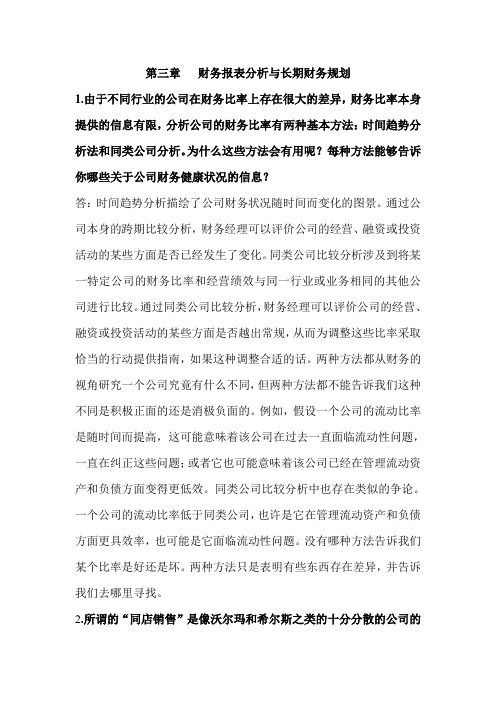
第三章财务报表分析与长期财务规划1.由于不同行业的公司在财务比率上存在很大的差异,财务比率本身提供的信息有限,分析公司的财务比率有两种基本方法:时间趋势分析法和同类公司分析。
为什么这些方法会有用呢?每种方法能够告诉你哪些关于公司财务健康状况的信息?答:时间趋势分析描绘了公司财务状况随时间而变化的图景。
通过公司本身的跨期比较分析,财务经理可以评价公司的经营、融资或投资活动的某些方面是否已经发生了变化。
同类公司比较分析涉及到将某一特定公司的财务比率和经营绩效与同一行业或业务相同的其他公司进行比较。
通过同类公司比较分析,财务经理可以评价公司的经营、融资或投资活动的某些方面是否越出常规,从而为调整这些比率采取恰当的行动提供指南,如果这种调整合适的话。
两种方法都从财务的视角研究一个公司究竟有什么不同,但两种方法都不能告诉我们这种不同是积极正面的还是消极负面的。
例如,假设一个公司的流动比率是随时间而提高,这可能意味着该公司在过去一直面临流动性问题,一直在纠正这些问题;或者它也可能意味着该公司已经在管理流动资产和负债方面变得更低效。
同类公司比较分析中也存在类似的争论。
一个公司的流动比率低于同类公司,也许是它在管理流动资产和负债方面更具效率,也可能是它面临流动性问题。
没有哪种方法告诉我们某个比率是好还是坏。
两种方法只是表明有些东西存在差异,并告诉我们去哪里寻找。
2.所谓的“同店销售”是像沃尔玛和希尔斯之类的十分分散的公司的一项重要指标,顾名思义,分析同店销售就是比较同样的店铺或餐馆在两个不同的时间点上的销售额。
为什么公司总是关注同店销售而不是总销售?答:如果一家公司通过开设新店来不断增长,那么可以推测其总收入将上升。
比较两个不同时点的总销售额可能会误导。
同店销售方法只看在特定时期开设的店铺的销售额控制了这一误差。
3.为什么多数长期财务计划都从销售预测开始?或者说,为什么未来销售额是关键?答:理由是,最终,消费是商业背后的驱动力。
兹维博迪-投资学-第九版-中文PPT课件

1-25
-
系统性风险的上升
银行资产和负债的到期日和流动性之间并不匹配。
负债是短期的、流动的 资产是长期的、非流动的 需要不断再融资改善资产组合
高杠杆比率使得银行几乎没有保证金来确保其安全。
1-26
-
系统性风险的上升
投资者过分依赖结构化产品,如信用违约掉期来实现信 用升级。
信用违约掉期合约通常是场外交易,缺少公开披露,没 有要求保证金。
为什么会低估信用风险?
没有人会预料到房地产市场的价格会一直下跌 跨地区来分散风险的愿望并未实现 代理问题和评级机构 信用违约掉期并未像预计那样降低风险
1-22
-
信用违约掉期 (CDS)
信用违约掉期实质上是一种针对借款者违约的保险合同。 投资者购买次级贷款使用信用违约掉期来保证其安全性。
投资银行
• 同意买下新发行的股票 和债券
• 在一级市场上向公众销 售新证券
• 投资者在二级市场上买 卖一级市场发行的证券
商业银行
• 吸收存款、发放贷款
1-14
-
-
2008年的金融危机
金融危机的前情:
“大稳健”: 美国经历了一个低利率和经济稳定的时期,只有一 些温和的经济衰退,经济周期似乎已被驯服。
第一章
1
投资环境
McGraw-Hill/Irwin
Copyright © 2011 by The McGraw-Hill Companies, Inc. All rights reserved.
-
-
实物资产与金融资产
实物资产 取决于该社会经济的生产能力,为经济创 造净利润。 如土地、建筑物、机器以及可用于生产产 品和提供服务的知识。
投资学课件—博迪第九版—Ch03 Types of Orders & Margin Accounts
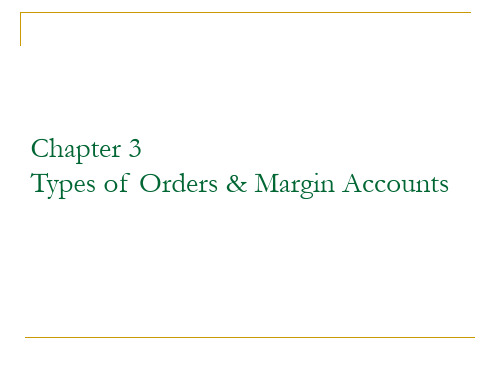
Exercise 2
On January 1, you sold short one round lot (that is, 100 shares) of Zenith stock at $14 per share. On March 1, a dividend of $2 per share was paid. On April 1, you covered the short sale by buying the stock at a price of $9 per share. You paid 50 cents per share in commissions for each transaction. What is the value of your account on April 1?
Stock $10,000
New position
Borrowed $4,000 Equity $3,000
Stock price falls to $70 per share Stock $7,000
Margin% = $3,000/$7,000 = 43%
How far can the stock price fall before a margin call?
Sale Proceeds initial margin
New position
Stock price rises to $110 Sale Proceeds $100,000 Initial Margin $50,000 Stock Owed $110,000 Net Equity $40,000 Margin% = $40,000/ $110,000 = 36%
公司理财中文版第九版第三章答案

第三章财务报表分析与长期财务1.由于不同行业的公司在财务比率上存在特别大的差异,财务比率本身提供的信息有限,分析公司的财务比率有两种全然方法:时刻趋势分析法和同类公司分析。
什么缘故这些方法会有用呢?每种方法能够告诉你哪些关于公司财务健康状况的信息?答:时刻趋势分析描绘了公司财务状况随时刻而变化的图景。
通过公司本身的跨期比立分析,财务经理能够评价公司的经营、融资或投资活动的某些方面是否差不多发生了变化。
同类公司比立分析涉及到将某一特定公司的财务比率和经营绩效与同一行业或业务相同的其他公司进行比立。
通过同类公司比立分析,财务经理能够评价公司的经营、融资或投资活动的某些方面是否越出常规,从而为调整这些比率采取恰当的行动提供指南,要是这种调整适宜的话。
两种方法都从财务的视角研究一个公司究竟有什么不同,但两种方法都不能告诉我们这种不同是积极正面的依旧消极负面的。
例如,假设一个公司的流淌比率是随时刻而提高,这可能意味着该公司在过往一直面临流淌性咨询题,一直在纠正这些咨询题;或者它也可能意味着该公司差不多在治理流淌资产和负债方面变得更低效。
同类公司比立分析中也存在类似的争论。
一个公司的流淌比率低于同类公司,也许是它在治理流淌资产和负债方面更具效率,也可能是它面临流淌性咨询题。
没有哪种方法告诉我们某个比率是好依旧坏。
两种方法只是讲明有些东西存在差异,并告诉我们往哪里寻寻。
2.所谓的“同店销售〞是像沃尔玛和希尔斯之类的十分分散的公司的一项重要指标,顾名思义,分析同店销售确实是根基比立同样的店展或餐馆在两个不同的时刻点上的销售额。
什么缘故公司总是关注同店销售而不是总销售?答:要是一家公司通过开设新店来不断增长,那么能够推测其总收进将上升。
比立两个不同时点的总销售额可能会误导。
同店销售方法只瞧在特定时期开设的店展的销售额操纵了这一误差。
3.什么缘故多数长期财务方案都从销售推测开始?或者讲,什么缘故今后销售额是要害?答:理由是,最终,消费是商业背后的驱动力。
博迪投资学第九版-Investment-Chap013-习题答案
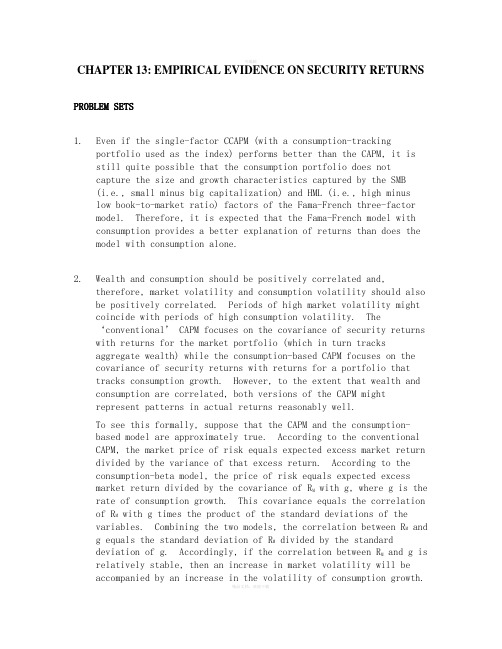
CHAPTER 13: EMPIRICAL EVIDENCE ON SECURITY RETURNS PROBLEM SETS1. Even if the single-factor CCAPM (with a consumption-trackingportfolio used as the index) performs better than the CAPM, it is still quite possible that the consumption portfolio does notcapture the size and growth characteristics captured by the SMB(i.e., small minus big capitalization) and HML (i.e., high minuslow book-to-market ratio) factors of the Fama-French three-factor model. Therefore, it is expected that the Fama-French model with consumption provides a better explanation of returns than does the model with consumption alone.2. Wealth and consumption should be positively correlated and,therefore, market volatility and consumption volatility should also be positively correlated. Periods of high market volatility might coincide with periods of high consumption volatility. The‘conventional’ CAPM focuses on the covariance of security returns with returns for the market portfolio (which in turn tracksaggregate wealth) while the consumption-based CAPM focuses on the covariance of security returns with returns for a portfolio thattracks consumption growth. However, to the extent that wealth and consumption are correlated, both versions of the CAPM mightrepresent patterns in actual returns reasonably well.To see this formally, suppose that the CAPM and the consumption-based model are approximately true. According to the conventional CAPM, the market price of risk equals expected excess market return divided by the variance of that excess return. According to theconsumption-beta model, the price of risk equals expected excessmarket return divided by the covariance of R M with g, where g is the rate of consumption growth. This covariance equals the correlation of R M with g times the product of the standard deviations of thevariables. Combining the two models, the correlation between R M andg equals the standard deviation of R M divided by the standarddeviation of g. Accordingly, if the correlation between R M and g is relatively stable, then an increase in market volatility will beaccompanied by an increase in the volatility of consumption growth.Note: For the following problems, the focus is on the estimation procedure. To keep the exercise feasible, the sample was limited to returns on nine stocks plus a market index and a second factor over a period of 12 years. The data were generated to conform to a two-factor CAPM so that actual rates of return equal CAPMexpectations plus random noise, and the true intercept of the SCL is zero for all stocks. The exercise will provide a feel for the pitfalls of verifying social-science models. However, due to the small size of the sample, results are not always consistent withthe findings of other studies as reported in the chapter.3. Using the regression feature of Excel with the data presented inthe text, the first-pass (SCL) estimation results are:Stock:A B C D E F G H I R Square0.060.060.060.370.170.590.060.670.70ObservationBeta-0.470.590.42 1.380.90 1.780.66 1.91 2.08t-Alpha0.73-0.04-0.06-0.410.05-0.450.33-0.270.64t-Beta-0.810.780.78 2.42 1.42 3.830.78 4.51 4.814. The hypotheses for the second-pass regression for the SML are:•The intercept is zero; and,•The slope is equal to the average return on the index portfolio.5. The second-pass data from first-pass (SCL) estimates are:AverageBetaExcessReturnA 5.18-0.47B 4.190.59C 2.750.42D 6.15 1.38E8.050.90F9.90 1.78G11.320.66H13.11 1.91I22.83 2.08M8.12S The second-pass regression yields:Regression StatisticsMultiple R 0.7074R Square0.5004Adjusted RSquare0.4291Standard Error 4.6234 Observations9Coefficients StandardErrortStatisticfor β=0tStatisticforIntercept 3.92 2.54 1.54Slope 5.21 1.97 2.65-1.486. As we saw in the chapter, the intercept is too high (3.92% per yearinstead of 0) and the slope is too flat (5.21% instead of apredicted value equal to the sample-average risk premium: r M r f =8.12%). The intercept is not significantly greater than zero (thet-statistic is less than 2) and the slope is not significantlydifferent from its theoretical value (the t-statistic for thishypothesis is 1.48). This lack of statistical significance isprobably due to the small size of the sample.7. Arranging the securities in three portfolios based on betas fromthe SCL estimates, the first pass input data are:Year ABC DEG FHI115.0525.8656.692-16.76-29.74-50.85319.67-5.688.984-15.83-2.5835.41547.1837.70-3.256-2.2653.8675.447-18.6715.3212.508-6.3536.3332.1297.8514.0850.421021.4112.6652.1411-2.53-50.71-66.1212-0.30-4.99-20.10 Average 4.048.5115.28Std.Dev.19.3029.4743.96(continued on next page)The first-pass (SCL) estimates are:ABC DEG FHIR Square0.040.480.82Observation121212Alpha 2.580.54-0.34Beta0.180.98 1.92t-Alpha0.420.08-0.06t-Beta0.62 3.02 6.83Grouping into portfolios has improved the SCL estimates as is evident from the higher R-square for Portfolio DEG and Portfolio FHI. This means that the beta (slope) is measured with greater precision, reducing the error-in-measurement problem at the expense of leaving fewer observations for the second pass.The inputs for the second pass regression are:AverageExcessReturnBetaABC 4.040.18DEH8.510.98FGI15.28 1.92M8.12The second-pass estimates are:RegressionMultiple R0.9975R Square0.9949Adjusted RSquare0.9899Standard Error0.5693Observations3Coefficients StandardErrortStatisticfor β =0tStatisticfor βIntercept 2.620.58 4.55Slope 6.470.4614.03-3.58Despite the decrease in the intercept and the increase in slope, the intercept is now significantly positive, and the slope is significantly less than the hypothesized value by more than three times the standard error.8. Roll’s critique suggests that the problem b egins with the marketindex, which is not the theoretical portfolio against which thesecond pass regression should hold. Hence, even if therelationship is valid with respect to the true (unknown) index, we may not find it. As a result, the second pass relationship may be meaningless.9.Except for Stock I, which realized an extremely positive surprise, the CML shows that the index dominates all other securities, and the three portfolios dominate all individual stocks. The power of diversification is evident despite the very small sample size.10. The first-pass (SCL) regression results are summarized below:A B C D E F G H IR-Square0.070.360.110.440.240.840.120.680.71Observatio121212121212121212 nsIntercept9.19-1.89-1.00-4.480.17-3.47 5.32-2.64 5.66Beta M-0.470.580.41 1.390.89 1.790.65 1.91 2.08Beta F-0.35 2.330.67-1.05 1.03-1.95 1.150.430.48 t-Intercept0.71-0.13-0.08-0.370.01-0.520.29-0.280.59t-Beta M-0.770.870.75 2.46 1.40 5.800.75 4.35 4.65 t-Beta F-0.34 2.060.71-1.080.94-3.690.770.570.6311. The hypotheses for the second-pass regression for the two-factorSML are:•The intercept is zero;•The market-index slope coefficient equals the market-index average return; and,•The factor slope coefficient equals the average return on thefactor.(Note that the first two hypotheses are the same as those for the single factor model.)12. The inputs for the second pass regression are:AverageExcessReturnBeta M Beta FA 5.18-0.47-0.35B 4.190.58 2.33C 2.750.410.67D 6.15 1.39-1.05E8.050.89 1.03F9.90 1.79-1.95G11.320.65 1.15H13.11 1.910.43I22.83 2.080.48M8.12F0.60The second-pass regression yields:Regression StatisticsMultiple R0.7234R Square0.5233Adjusted RSquare0.3644Standard Error 4.8786Observations9Coefficients StandardErrortStatisticfor β =0tStatisticfor βtStatisticfor βIntercept 3.35 2.88 1.16Beta M 5.53 2.16 2.56-1.20Beta F0.80 1.420.560.14These results are slightly better than those for the single factor test; that is, the intercept is smaller and the slope on M is slightly greater. We cannot expect a great improvement since the factor we added does not appear to carry a large risk premium (average excess return is less than 1%), and its effect on mean returns is therefore small. The data do not reject the second factor because the slope is close to the average excess return and the difference is less than one standard error. However, with this sample size, the power of this test is extremely low.13. When we use the actual factor, we implicitly assume that investorscan perfectly replicate it, that is, they can invest in a portfolio that is perfectly correlated with the factor. When this is notpossible, one cannot expect the CAPM equation (the second passregression) to hold. Investors can use a replicating portfolio (aproxy for the factor) that maximizes the correlation with thefactor. The CAPM equation is then expected to hold with respect to the proxy portfolio.Using the bordered covariance matrix of the nine stocks and theExcel Solver we produce a proxy portfolio for factor F, denoted PF.To preserve the scale, we include constraints that require the nine weights to be in the range of [-1,1] and that the mean equal thefactor mean of 0.60%. The resultant weights for the proxy andperiod returns are:Proxy Portfolio for Factor F(PF)Weightson Universe YearPF HoldingPeriodReturnsA-0.141-33.51B 1.00262.78C0.9539.87D-0.354-153.56E0.165200.76F-1.006-36.62G0.137-74.34H0.198-10.84I0.06928.111059.5111-59.151214.22Average0.60This proxy (PF) has an R-square with the actual factor of 0.80.We next perform the first pass regressions for the two factor model using PF instead of P:A B C D E F G H I R-square0.080.550.200.430.330.880.160.710.72 Observations121212121212121212Intercept9.28-2.53-1.35-4.45-0.23-3.20 4.99-2.92 5.54 Beta M-0.500.800.49 1.32 1.00 1.640.76 1.97 2.12 Beta PF-0.060.420.16-0.130.21-0.290.210.110.08 t- 0.72-0.21-0.12-0.36-0.02-0.550.27-0.330.58 t-Beta M-0.83 1.430.94 2.29 1.66 6.000.90 4.67 4.77t-Beta PF-0.44 3.16 1.25-0.97 1.47-4.52 1.03 1.130.78Note that the betas of the nine stocks on M and the proxy (PF) are different from those in the first pass when we use the actual proxy.The first-pass regression for the two-factor model with the proxy yields:AverageExcessReturnBeta M Beta PFA 5.18-0.50-0.06B 4.190.800.42C 2.750.490.16D 6.15 1.32-0.13E8.05 1.000.21F9.90 1.64-0.29G11.320.760.21H13.11 1.970.11I22.83 2.120.08M8.12PF0.6The second-pass regression yields:Regression StatisticsMultiple R0.71R Square0.51Adjusted RSquare0.35Standard Error 4.95Observations9Coefficien ts StandardErrortStatisticfor β =0tStatisticfor βtStatisticfor βIntercept 3.50 2.99 1.17Beta M 5.39 2.18 2.48-1.25Beta PF0.268.360.03-0.04We can see that the results are similar to, but slightly inferior to, those with the actual factor, since the intercept is larger and the slope coefficient smaller. Note also that we use here an in-sample test rather than tests with future returns, which is more forgiving than an out-of-sample test.14. We assume that the value of your labor is incorporated in thecalculation of the rate of return for your business. It wouldlikely make sense to commission a valuation of your business atleast once each year. The resultant sequence of figures forpercentage change in the value of the business (including net cash withdrawals from the business in the calculations) will allow you to derive a reasonable estimate of the correlation between the rate of return for your business and returns for other assets. Youwould then search for industries having the lowest correlationswith your portfolio, and identify exchange traded funds (ETFs) for these industries. Your asset allocation would then be comprised of your business, a market portfolio ETF, and the low-correlation(hedge) industry ETFs. Assess the standard deviation of such aportfolio with reasonable proportions of the portfolio invested in the market and in the hedge industries. Now determine where youwant to be on the resultant CAL. If you wish to hold a less risky overall portfolio and to mix it with the risk-free asset, reducethe portfolio weights for the market and for the hedge industries in an efficient way.CFA PROBLEMS1. (i) Betas are estimated with respect to market indexes that areproxies for the true market portfolio, which is inherentlyunobservable.(ii) Empirical tests of the CAPM show that average returns are not related to beta in the manner predicted by the theory. Theempirical SML is flatter than the theoretical one.(iii) Multi-factor models of security returns show that beta, which is a one-dimensional measure of risk, may not capture the true risk of the stock of portfolio.2. a. The basic procedure in portfolio evaluation is to compare thereturns on a managed portfolio to the return expected on anunmanaged portfolio having the same risk, using the SML. Thatis, expected return is calculated from:E(r P ) = r f + βP [E(r M ) – r f ]where r f is the risk-free rate, E(r M ) is the expected return for the unmanaged portfolio (or the market portfolio), and βP is the beta coefficient (or systematic risk) of the managed portfolio. The performance benchmark then is the unmanaged portfolio. The typical proxy for this unmanaged portfolio is an aggregate stock market index such as the S&P 500.b. The benchmark error might occur when the unmanaged portfolioused in the evaluation process is not “optimized.” That is, market indices, such as the S&P 500, chosen as benchmarks are not on the manager’s ex ante mean/variance efficient frontier.c. Your graph should show an efficient frontier obtained fromactual returns, and a different one that represents (unobserved) ex-ante expectations. The CML and SML generated from actualreturns do not conform to the CAPM predictions, while thehypothesized lines do conform to the CAPM.d. The answer to this question depends on one’s prior beliefs.Given a consistent track record, an agnostic observer mightconclude that the data support the claim of superiority. Otherobservers might start with a strong prior that, since so manymanagers are attempting to beat a passive portfolio, a smallnumber are bound to produce seemingly convincing track records.e. The question is really whether the CAPM is at all testable.The problem is that even a slight inefficiency in the benchmarkportfolio may completely invalidate any test of the expectedreturn-beta relationship. It appears from Roll’s argumentthat the best guide to the question of the validity of the CAPMis the difficulty of beating a passive strategy.3. The effect of an incorrectly specified market proxy is that thebeta of Black’s portfolio is likely to be underestimated (i.e., too low) rel ative to the beta calculated based on the “true”market portfolio. This is because the Dow Jones Industrial Average (DJIA) and other market proxies are likely to have lessdiversification and therefore a higher variance of returns than the “true” market p ortfolio as specified by the capital asset pricing model. Consequently, beta computed using an overstated variance will be underestimated. This result is clear from the following formula:2Proxy Mark et Proxy Mark et Portfolio Portfolio )r ,r (Cov σ=βAn incorrectly specified market proxy is likely to produce a slope for the security market line (i.e., the market risk premium) that is underestimated relative to the “true” market portfolio. This results from the fact that the “true” market portfolio is likely to be more efficient (plotting on a higher return point for thesame risk) than the DJIA and similarly misspecified market proxies.Consequently, the proxy-based SML would offer less expected return per unit of risk..。
Zvi Bodie《投资学》 (第9版中文)第二章金融工具(一)
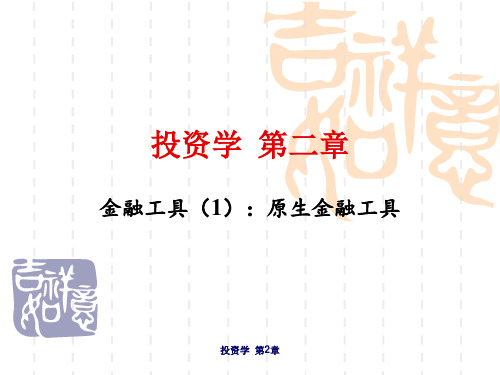
注意:有报价风险。 非竞争性:是无条件的,以成功的竞争性报价 的平均价格为国库券的成交价,最大购买额为 每一定单不能超过100万美元。
按照投资者报价的高低排序,依次向竞争 性与非竞争性投资者出售国库券,直至国 库券全部售完为止。
投资学 第2章
短期国债的收益率计算方法——银行 折现收益率
期限为182天(26周)的票面价值为10000美元的 国库券,售价为9600美元 半年的收益率为:400/9600=0.0417 年收益率r=(1+0.0417)2-1=8.51% 银行折现(bank discount method)收益率为
投资学 第2章
2.2.1 中、长期国债
中期国债(T-Notes):一年以上10年以下 长期国债(T-Bonds) :10年~30年。 国债的收益(资本利得和利息)可以免税。 美国:两者都是以1000美元的面值发行, 每半年付息一次,属于息票(Coupon)债 券。
投资学 第2章
货币市场工具
金 融 工 具
资本市场工具பைடு நூலகம்
固定收益证券 股票 衍生金融工具
投资学 第2章
Historical Returns
Investment U.S. Treasury Bills Intermediate-term T-bonds Long term T-bonds U.S. Corporate bonds (AAA) Non-U.S. bonds (AAA) U.S. common stocks (S&P 500) U.S. common stocks (small cap) Non-U.S. common stocks (in $ terms) U.S. real estate U.S. inflation rate (annual rate) Total Return, Total Return, 1929-1993 1984-1993 3.7% 5.3% 5.0% 5.6% n/a 9.5% 12.0% n/a n/a 3.2%
博迪《投资学》(第9版)配套题库【章节题库】第1章~第4章 【圣才出品】
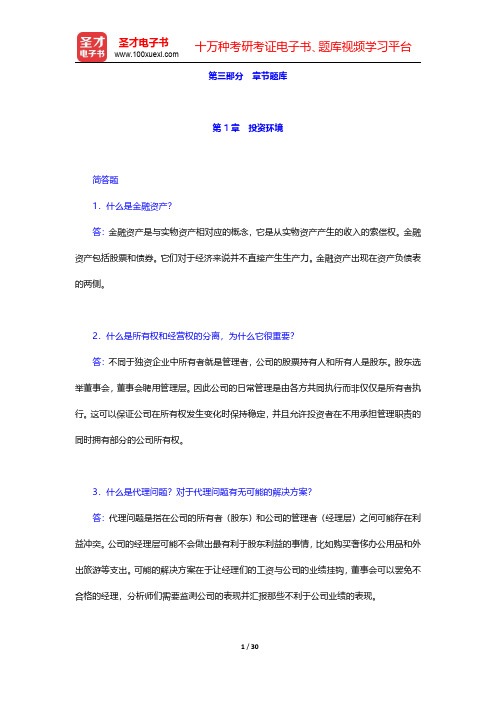
第三部分章节题库第1章投资环境简答题1.什么是金融资产?答:金融资产是与实物资产相对应的概念,它是从实物资产产生的收入的索偿权。
金融资产包括股票和债券。
它们对于经济来说并不直接产生生产力。
金融资产出现在资产负债表的两侧。
2.什么是所有权和经营权的分离,为什么它很重要?答:不同于独资企业中所有者就是管理者,公司的股票持有人和所有人是股东。
股东选举董事会,董事会聘用管理层。
因此公司的日常管理是由各方共同执行而非仅仅是所有者执行。
这可以保证公司在所有权发生变化时保持稳定,并且允许投资者在不用承担管理职责的同时拥有部分的公司所有权。
3.什么是代理问题?对于代理问题有无可能的解决方案?答:代理问题是指在公司的所有者(股东)和公司的管理者(经理层)之间可能存在利益冲突。
公司的经理层可能不会做出最有利于股东利益的事情,比如购买奢侈办公用品和外出旅游等支出。
可能的解决方案在于让经理们的工资与公司的业绩挂钩,董事会可以罢免不合格的经理,分析师们需要监测公司的表现并汇报那些不利于公司业绩的表现。
4.什么是风险分配,为什么说它重要?答:风险分配是指公司企业可以发行不同风险的债券,投资者可以根据他们的偏好选择不同风险等级的资产。
由于不同风险收益的特征,可以让公司企业筹集所需资本,也可以让投资者做不同的投资选择。
风险分配方式对于需要筹集资金来支持其投资的公司而言是有利的。
当投资者都能够选择具有适合自身风险偏好的风险一收益特征的证券类型时,每种证券都能以最合适的价格出售,这加速了实物资产股票化的建立过程。
第2章资产类别与金融工具一、选择题1.证券交易所发布的股票价格指数所采用的计算方法通常采用的是()。
[东北财大2012研]A.算术平均法B.综合平均法C.加权平均法D.加权几何平均法【答案】C【解析】股价指数是将计算期的股价或市值与某一基期的股价或市值相比较的相对变化值,用以反映市场股票价格的相对水平。
股价指数的编制方法有简单算术股价指数和加权股价指数两类。
投资学第九版课后答案,博迪投资学第九版课后答案
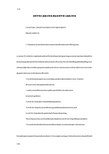
投资学第九版课后答案,博迪投资学第九版课后答案CHAPTER1:THEINVESTMENTENVIRONMENTPROBLEMSETS1.Ultimately,itistruethatrealassetsdeterminethematerialwellbeingofaneconomy.Nevertheless,inpidualscanbenefitwhenfinancialengineeringcreatesnewproductsthatallowt hemtomanagetheirportfoliosoffinancialassetsmoreefficiently.Becausebundlingandunbundlingcreat esfinancialproductswithnewpropertiesandsensitivitiestovarioussourcesofrisk,itallowsinvestorstohe dgeparticularsourcesofriskmoreefficiently.2.Securitizationrequiresaccesstoalargenumberofpotentialinvestors.Toattracttheseinvestors,thecapitalmarketneeds:1.asafesystemofbusinesslawsandlowprobabilityofconfiscatorytaxation/regulation;2.awell-developedinvestmentbankingindustry;3.awell-developedsystemofbrokerageandfinancialtransactions,and;4.well-developedmedia,particularlyfinancialreporting.Thesecharacteristicsarefoundin(indeedmakefor)awell-developedfinancialmarket.3.Securitizationleadstodisintermediation;thatis,securitizationprovidesameansformarketparticipantstobypassintermediaries.Forexample,mortgage-backedsecuritieschannelfundstothehousingmarketwithoutrequiringthatbanksorthriftinstitutionsmakeloansfromtheirownportfolios. Assecuritizationprogresses,financialintermediariesmustincreaseotheractivitiessuchasprovidingshort-termliquiditytoconsumersandsmallbusiness,andfinancialservices.Financialassetsmakeiteasyforlargefirmstoraisethecapitalneededtofinancetheirinvestmentsinrealasse ts.IfFord,forexample,couldnotissuestocksorbondstothegeneralpublic,itwouldhaveafarmoredifficultt imeraisingcapital.Contractionofthesupplyoffinancialassetswouldmakefinancingmoredifficult,there byincreasingthecostofcapital.Ahighercostofcapitalresultsinlessinvestmentandlowerrealgrowth.4. 1-15.Evenifthefirmdoesnotneedtoissuestockinanyparticularyear,thestockmarketisstillimportanttothefinancialmanager.Thestockpriceprovidesimportantinformationabouthowthemarketvaluesthefirmsinvestmentprojects.Forexample,ifthestockpricerises considerably,managersmightconcludethatthemarketbelievesthefirmsfutureprospectsarebright.Thismightbeausefulsignaltothefirmtoproceedwithaninves tmentsuchasanexpansionofthefirmsbusiness.Inaddition,sharesthatcanbetradedinthesecondarymarke taremoreattractivetoinitialinvestorssincetheyknowthattheywillbeabletoselltheirshares.Thisinturnma kesinvestorsmorewillingtobuysharesinaprimaryoffering,andthusimprovesthetermsonwhichfirmsca nraisemoneyintheequitymarket.6.a.No.Theincreaseinpricedidnotaddtotheproductivecapacityoftheeconomy.b.Yes,thevalueoftheequit yheldintheseassetshasincreased.c.Futurehomeownersasawholeareworseoff,sincemortgageliabilitieshavealsoincreased.Inaddition,thishousingpricebubblewilleventuallyburstandsocietyasawhole(andmostlikelytaxpayers)willendurethedamage.7.a.ThebankloanisafinancialliabilityforLanni.(LannisIOUisthebanksfinancialasset.)ThecashLannirec eivesisafinancialasset.ThenewfinancialassetcreatedisLannispromissorynote(thatis,Lanni’sIOUtothebank).nnitransfersfinancialassets(cash)tothesoftwaredevelopers.Inreturn,Lannigetsarealasset,thecompletedsoftware.Nofinancialassetsarecreatedordestroyed;cashissimplytra nsferredfromonepartytoanother.nnigivestherealasset(thesoftware)toMicrosoftinexchangeforafinancialasset,1,500sharesofMicr osoftstock.IfMicrosoftissuesnewsharesinordertopayLanni,thenthiswouldrepresentthecreationofnew financialassets.nniexchangesonefinancialasset(1,500sharesofstock)foranother($120,000).Lannigivesafinancialasset($50,000cash)tothebankandgetsbackanotherfinancialasset(itsIOU).Theloanisdestroyedinthetransaction,sinceitisretiredwhenpaidoffandnolongerexists.1-28.a.LiabilitiesShareholders’equityCash$70,000Bankloan$50,000computersShareholders’equityTotal$100,000Total$100,000Ratioofrealassetstototalassets=$30,000/$100,000=0.30Assetsb.AssetsSoftwareproduct*computersTotal*ValuedatcostRatioofrealassetstototalassets=$100,000/$100,000=1.0c.AssetsMicrosoftsharescomputersTotalLiabilitiesShareholders’equity$120,000Bankloan$50,000Shareholders’equity$150,000Total$150,000LiabilitiesShareholders’equity$70,000Bankloan$50,000Shareholders’equity$100,000Total$100,000Ratioofrealassetstototalassets=$30,000/$150,000=0.20Conclusion:whenthefirmstartsupandraisesworkingcapital,itischaracterizedbyalowratioofrealassetst ototalassets.Whenitisinfullproduction,ithasahighratioofrealassetstototalassets.Whentheprojectshuts downandthefirmsellsitoffforcash,financialassetsonceagainreplacerealassets.9.Forcommercialbanks,theratiois:$140.1/$11,895.1=0.0118Fornon-financialfirms,theratiois:$12,538/$26,572=0.4719Thedifferenceshouldbeexpectedprimarilybecausethebulkofthebusinessoffinancialinstitutionsistomakeloans;whicharefinancialassetsforfinancialinstitutions.10.a.Primary-markettransactionb.Derivativeassetsc.Investorswhowishtoholdgoldwithoutthecomplicationandcostofphysicalstorage.1-311.a.Afixedsalarymeansthatcompensationis(atleastintheshortrun)independentofthefirmssuccess.Thissalarystructuredoesnottiethemanager’simmediatecompensationtothesuccessofthefirm.However,themanagermightviewthisasthesafestcom pensationstructureandthereforevalueitmorehighly.b.Asalarythatispaidintheformofstockinthefirmmeansthatthemanagerearnsthemostwhenthesharehol ders’wealthismaximized.Fiveyearsofvestinghelpsaligntheinterestsoftheemployeewiththelong-termperformanceofthefirm.Thisstructureisthereforemostlikelytoaligntheinterestsofmanagersandshareholders. Ifstockcompensationisoverdone,however,themanagermightviewitasoverlyriskysincethemanager’scareerisalreadylinkedtothefirm,andthisunpersifiedexposurewouldbeexacerbatedwithalargestockpo sitioninthefirm.c.Aprofit-linkedsalarycreatesgreatincentivesformanagerstocontributetothefirm’ssuccess.However,amanagerwhosesalaryistiedtoshort-termprofitswillberiskseeking,especiallyifthe seshort-termprofitsdeterminesalaryorifthecompensationstructuredoesnotbearthefullcostoftheproject’srisks.Shareholders,incontrast,bearthelossesaswellasthegainsontheproject,andmightbelesswillingtoassumethatrisk.12.Evenifaninpidualshareholdercouldmonitorandimprovemanagers’performance,andtherebyincreasethevalueofthefirm,thepayoffwouldbesmall,sincetheownershipshareinalargecorporationwouldbeverysmall.Forexample,ifyouown$10,000ofFordstocka ndcanincreasethevalueofthefirmby5%,averyambitiousgoal,youbenefitbyonly:0.05×$10,000=$500Incontrast,abankthathasamultimillion-dollarloanoutstandingtothefirmhasabigstakeinmakingsuretha tthefirmcanrepaytheloan.Itisclearlyworthwhileforthebanktospendconsiderableresourcestomonitort hefirm.13.Mutualfundsacceptfundsfromsmallinvestorsandinvest,onbehalfoftheseinvestors,inthenationalandinternationalsecuritiesmarkets.Pensionfundsacceptfundsandtheninvest,onbehalfofcurrentandfutureretirees,therebychannelingfund sfromonesectoroftheeconomytoanother.Venturecapitalfirmspoolthefundsofprivateinvestorsandinvestinstart-upfirms.Banksacceptdepositsfr omcustomersandloanthosefundstobusinesses,orusethefundstobuysecuritiesoflargecorporations.Treasurybillsserveapurposeforinvestorswhopreferalow-riskinvestment.Theloweraveragerateofreturncomparedtostocksisthepriceinvestorspayforpredictabilityofinvestmentperformanceandportfoliovalue.14.1-415.Witha“top-down”investingstyle,youfocusonassetallocationorthebroadcompositionoftheentireportfolio,whichisthemajordeterminantofoverallperformance.Moreover,top-downmanagementisthenaturalwaytoestablishaportfoliowithalevelofriskconsistentwithyourrisktoler ance.Thedisadvantageofanexclusiveemphasisontop-downissuesisthatyoumayforfeitthepotentialhig hreturnsthatcouldresultfromidentifyingandconcentratinginundervaluedsecuritiesorsectorsofthemar ket.Witha“bottom-up”investingstyle,youtrytobenefitfromidentifyingundervaluedsecurities.Thedisadva ntageisthatyoutendtooverlooktheoverallcompositionofyourportfolio,whichmayresultinanon-persifi edportfoliooraportfoliowitharisklevelinconsistentwithyourlevelofrisktolerance.Inaddition,thistechn iquetendstorequiremoreactivemanagement,thusgeneratingmoretransactioncosts.Finally,youranalysi smaybeincorrect,inwhichcaseyouwillhavefruitlesslyexpendedeffortandmoneyattemptingtobeatasimplebuy-and-holdstrategy.Youshouldbeskeptical.Iftheauthoractuallyknowshowtoachievesuchreturns,onemustquestionwhythe authorwouldthenbesoreadytosellthesecrettoothers.Financialmarketsareverycompetitive;oneoftheim plicationsofthisfactisthatrichesdonotcomeeasily.Highexpectedreturnsrequirebearingsomerisk,ando bviousbargainsarefewandfarbetween.Oddsarethattheonlyonegettingrichfromthebookisitsauthor.16.。
投资学_博迪_第九版_中文答案_第三章
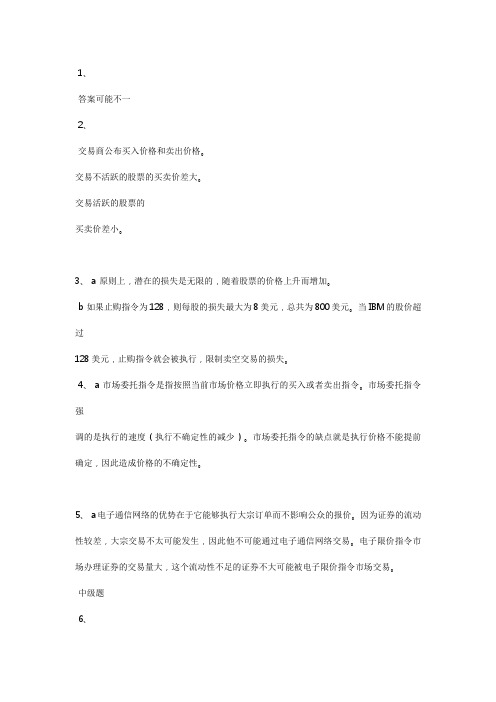
1、答案可能不一2、交易商公布买入价格和卖出价格。
交易不活跃的股票的买卖价差大。
交易活跃的股票的买卖价差小。
3、 a 原则上,潜在的损失是无限的,随着股票的价格上升而增加。
b 如果止购指令为128,则每股的损失最大为8美元,总共为800美元。
当IBM的股价超过128美元,止购指令就会被执行,限制卖空交易的损失。
4、 a 市场委托指令是指按照当前市场价格立即执行的买入或者卖出指令。
市场委托指令强调的是执行的速度(执行不确定性的减少)。
市场委托指令的缺点就是执行价格不能提前确定,因此造成价格的不确定性。
5、 a电子通信网络的优势在于它能够执行大宗订单而不影响公众的报价。
因为证券的流动性较差,大宗交易不太可能发生,因此他不可能通过电子通信网络交易。
电子限价指令市场办理证券的交易量大,这个流动性不足的证券不大可能被电子限价指令市场交易。
中级题6、a 股票购买价格为:300*$40=$12000.借款为$4000,因此投资者权益(保证金)为:$8000 b 股票的价值为:300*$30=$9000。
年末借款变为:$4,000 × 1.08 = $4,320。
因此,投资者账户中的剩余保证金为:$9,000 − $4,320 = $4,680,则保证金比例为:$4,680/$9,000 = 0.52 = 52%,因此投资者不会收到保证金催缴通知。
c投资收益率=(期末权益-期初权益)/期初权益=($4,680 − $8,000)/$8,000 = −0.415 = −41.5%7、 a 期初保证金是:0.50 × 1,000 × $40 = $20,000。
股票价格上涨,则投资者损失为:$10 × 1,000 = $10,000。
此外,投资者必须支付股利:$2 × 1,000 = $2,000,所以,剩余保证金为:$20,000 – $10,000 – $2,000 = $8,000。
《博迪-投资学》【中文版教材课后习题答案】
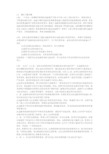
(1)安全的商业法规体系,较低的税负,较少的管制; (2)高度发达的投资银行业; (3)高度发达的经纪行和金融交易体系: (4)高度发达的信息系统,尤其是在财务披露方面。 这些都是一个高度发达的金融市场的必备条件,所以证券化只发生在高度发达的证券市 场上。
11.答:a.固定工资意味着管理者的报酬(至少在短期内)与公司的业绩无关,这种薪酬形 式难以将管理者的利益与公司业绩统一起来,不能解决二者的潜在利益冲突,即使管理者认 为固定工资是稳定的工资结构。 b.将公司股票作为薪酬发放给管理者,在公司业绩好时,公司股价上升,管理者报酬上升。 这在一定程度上将管理者与股东的利益统一起来,能够促使管理者努力提升公司业绩,有助 于解决管理者与股东之间的潜在利益冲突。然而,如果股票补偿过度,管理者可能会认为这 过于冒险,因为管理者的事业与公司紧密相连。 C.与利润挂钩的工资制度将会激励管理者为公司的成功做出贡献。然而,工资与短期利润 挂钩的管理者会过于冒险,尤其是当短期利润决定工资,或者当回报无法补偿项目风险的全 部成本的时候。相比之下,承担着项目的损益的股东可能不太愿意承担这种风险。 12.答: (1)对管理者的监管是需要付出大量成本的,个人投资者的财力、精力和对公司的 控制权都不足以胜任对管理者的监管;而大机构投资者却可以运用其充足的财力、大量的专 业人才和对公司的有力的控制权来雇佣独立人士或在公司内部实行某种机制来对管理者进 行监管。 (2)在监管成本一定时,即使个人投资者可以监控和改善代理人的业绩,增加公司的市值, 但是这种回报会很少,因为个人在一个大公司中拥有的股票数量是非常少的。举例来说,假 如某人拥有 10000 美元通用汽车公司的股票,公司的市值增加了 5%而他仅仅能从中受益 500( 10000 X0.05)美元。相反,对于有几百万美元企业贷款的银行而言,确信企业能偿还贷 款是非常重要的。银行显然值得花费大量的资源去监控企业。 (3)对管理者的监管存在着外部经济效应,即某个股东在对管理者进行监管,他并不能得到 其监管活动的所有收益,因为其他股东也能从其监管中获得好处。当小股东执行监管时,外 部经济效应是非常大的;而大股东执行监管时,虽然仍存在着外部经济效应,却能降低这种 外部经济效应。
3投资学第三章习题答案
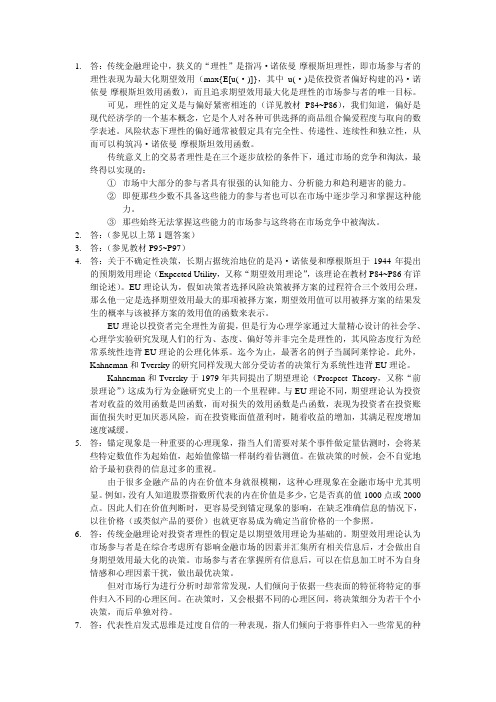
1.答:传统金融理论中,狭义的“理性”是指冯·诺依曼-摩根斯坦理性,即市场参与者的理性表现为最大化期望效用(max{E[u(·)]},其中u(·)是依投资者偏好构建的冯·诺依曼-摩根斯坦效用函数),而且追求期望效用最大化是理性的市场参与者的唯一目标。
可见,理性的定义是与偏好紧密相连的(详见教材P84~P86),我们知道,偏好是现代经济学的一个基本概念,它是个人对各种可供选择的商品组合偏爱程度与取向的数学表述。
风险状态下理性的偏好通常被假定具有完全性、传递性、连续性和独立性,从而可以构筑冯·诺依曼-摩根斯坦效用函数。
传统意义上的交易者理性是在三个逐步放松的条件下,通过市场的竞争和淘汰,最终得以实现的:①市场中大部分的参与者具有很强的认知能力、分析能力和趋利避害的能力。
②即便那些少数不具备这些能力的参与者也可以在市场中逐步学习和掌握这种能力。
③那些始终无法掌握这些能力的市场参与这终将在市场竞争中被淘汰。
2.答:(参见以上第1题答案)3.答:(参见教材P95~P97)4.答:关于不确定性决策,长期占据统治地位的是冯·诺依曼和摩根斯坦于1944年提出的预期效用理论(Expected Utility,又称“期望效用理论”,该理论在教材P84~P86有详细论述)。
EU理论认为,假如决策者选择风险决策被择方案的过程符合三个效用公理,那么他一定是选择期望效用最大的那项被择方案,期望效用值可以用被择方案的结果发生的概率与该被择方案的效用值的函数来表示。
EU理论以投资者完全理性为前提,但是行为心理学家通过大量精心设计的社会学、心理学实验研究发现人们的行为、态度、偏好等并非完全是理性的,其风险态度行为经常系统性违背EU理论的公理化体系。
迄今为止,最著名的例子当属阿莱悖论。
此外,Kahneman和Tversky的研究同样发现大部分受访者的决策行为系统性违背EU理论。
投资学(博迪) 中文 答案
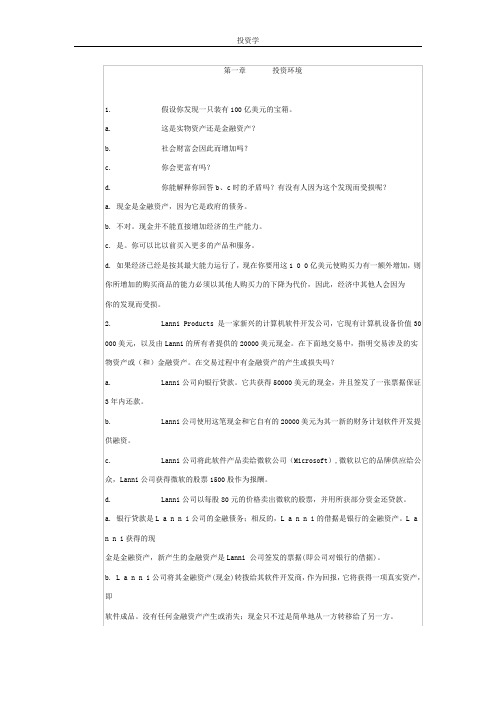
P=10 000[1-rB D(n/ 3 6 0 ) ],这里rB D是贴现率。
Pa s k =10 000[1-0.0681(60/360)]=9 886.50美元
( 2 5 0P-5 000)/250P=0.25或当P= 2 6 . 6 7美元时
收到追加保证金的通知。
c.但是现在你借入的是10 000美元而不是5 000美元。因此,股权仅为2 5 0P-10 000美元。你
会在
( 2 5 0P-10 000)/250P=0.25或当P= 5 3 . 3 3美元时
收益%=价格变动的%×总投资/投资者初始股权=价格变动的%×1 . 3 3 3
例如,当股票价格从8 0上涨至8 8时,价格变动百分率为1 0%,而投资者收益百分率是1 . 3 3 3倍,
即1 3 . 3 3%:
收益的%= 1 0%×20 000美元/15 000美元= 1 3 . 3 3%
b. 250股股票价值为2 5 0P。股权为2 5 0P-5 000。你会在
b. i.rB D=[(10 000-9 764)/10 000]×360/91=0.093 4
ii.rB D=[(10 000-9 539)/10 000]×360/182=0.091 2
第三章证券是如何交易的
1.假设Intel公司现以80美元/股的价格卖出股票,投资者买了250股,其中15000美元是投资者自有资金,其余则是投资者从经纪人处借得的,保证金贷款的利率是8%。
10.67%; -2.67%; -16%
投资学第3章参考答案.doc

第3章参考答案1.在投资领域中的风险是指金融资产价格波动给投资者收益率带来的不确定性,也就是说,风险的存在意味着尽管投资者一项投资(事后)的最终结果是唯一的,但在事前看来,由于各种影响因素的不确定性,投资者的投资可能会产生一个以上的结果。
一般来讲,金融领域关注的风险既包括损失发生的可能,也包括盈利发生的可能,而并不只是单纯考虑损失的情况。
投资风险具体来说,主要包括以下几方面内容。
(1)投资盈利和损失的概率,即盈利和损失各自发生的可能性。
(2)盈利和损失的程度,即盈利或损失发生后,各自的数量和幅度有多大。
(3)盈利和损失的易变形性,即在盈利和损失的范围内各自的易变程度。
2.金融市场上风险者面临的风险有多种分类方法,按风险来源可分为市场风险、通货膨胀风险、利率风险、汇率风险、信用风险、流动性风险、经营风险和政治风险;按能否分散可以分为系统性风险和非系统性风险。
3.在金融市场中,投资者对待风险的态度可以分为三类:风险厌恶型、风险中性型和风险偏好型。
风险厌恶型的投资者在面对相同的预期收益时,总是偏好风险较小的进行交易。
对于这类投资者来说,如果想使之接受交易中的风险,就必须在价格上给予足够的补偿,有风险交易的收益从结构上看应该是无风险交易的收益加上一个风险补偿额,而且风险补偿额与风险成正比。
风险中性型投资者并不关心风险的高低,他们只根据预期收益率的高低来进行决策,这意味着对这种投资者来说,风险并不是影响决策的障碍。
风险中性的投资者对自己承担的风险不要求风险补偿。
此类型的投资者投资决策的原则是:当预期收益相同时,他们偏好风险更大的资产,因为这会给他们带来更大的效用。
不同风险态度的效用函数如图:UCX) U(X)对于风险厌恶者,随着收益的增加效用提高,但效用提高的程度呈递减趋势。
风险厌恶者的效用函数是凹函数,即期望的效用大于效用的期望,表示为U[E(X)]〉E[U(X)]。
对于风险中性者,收益增加为投资者带来的边际效用是一个常数,因此,这种类型投资者的效用函数是线性的,即期望的效用等于效用的期望,表示为U[E(X)] = E[U(X)]。
博迪第九版投资学中文答案第1-4章

第1章:投资环境1.的确,实际资产决定经济的物质享受。
然而,当金融工程创建新产品时, 个人可以受益,可以让他们更有效地管理金融资产投资组合。
因为对于不同的风险来源,捆绑和拆分创造具有新属性和敏感性的金融产品,能让投资者更有效地对冲特定来源的风险。
2.证券化需要大量的潜在投资者。
为了吸引这些投资者,资本市场需求:1。
一个安全系统的商业法律和概率低的没收的税收法律/法规;2。
一个成熟的投资银行业;3。
成熟的经纪和金融交易系统,;4。
发达的媒介,尤其是财务报告。
这些特征在一个发达的金融市场中具有。
3.证券化导致金融脱媒;也就是说,证券化为市场参与者提供了一个手段绕过中介。
例如,抵押贷款支持证券是房地产市场获得资金不需要通过银行或储蓄机构发放贷款的投资组合。
随着资产证券化的发展,金融中介机构必须增加其他活动,例如向消费者和小型企业提供短期流动性,金融服务。
4.金融资产使大公司筹集支持实物资产投资的资本变得容易。
如果福特,例如,可以不向公众发行股票或债券,这将更难以筹集资金。
紧缩金融资产的供应将使融资更加困难,从而增加了资本成本。
更高的资本成本导致更少的投资和较低的实际增长。
5.即使公司不需要发行股票,股票市场对于财务经理依然很重要。
股票价格提供关于公司投资项目的市场价值的重要信息。
例如,如果股票价格大幅上涨,经理可能得出结论,认为公司的前景是光明的。
这对于公司继续投资扩大资产业务可能是个有用的信号。
此外,股票可以在二级市场交易是对初始投资者更具吸引力的方面,因为他们知道他们可以出售股票。
反过来这会使得市场投资者更愿意购买初始股票,从而使得公司更容易在股市筹集资金。
6. a、不会,价格的增加不会增加经济的生产能力。
b、是的,股票在这些资产的价值增加了。
c、未来业主作为一个整体更糟,因为抵押贷款债务也增加了。
此外,这个房价泡沫最终会破裂,社会作为一个整体将承受损失。
7.a 银行贷款是兰尼的金融负债,收到的现金是兰尼的金融资产。
投资学博迪第九版中文答案

基础题1、单位投资信托基金的运营费用应该较低。
因为一旦信托设立,信托投资组合是固定的,当市场改变时,它不需要支付投资组合经理不断监控和调整投资者组合的费用。
因为投资组合是固定的,所以单位投资信托基金几乎没有交易成本。
2、a单位信托基金:大规模投资的多元化,大规模交易的低成本,低管理费用,可预测的投资组合成分,投资组合的低换手率。
b开放式基金:大规模投资的多元化,大规模交易的低成本,专业的管理可以实现在机会出现时的买入或卖出,记录交易过程。
c个人自主选择的股票和债券:没有管理费用,在协调个人所得税的情况下实现资本利得或者损失,可以根据个人风险偏好来设计投资组合。
3、开放式基金是有义务以资产净值赎回投资者的股票,因此必须保持手头现金及现金证券以满足潜在的赎回。
封闭式基金不需要现金储备,因为对封闭式基金不能赎回。
封闭式基金的投资者希望套现时,他们会出售股票。
4、平衡基金以相对稳定的比例投资于每个资产类别,供投资者投资整个资产组合时选择使用。
生命周期基金属于平衡基金,其资产配置取决于投资者的年龄构成。
积极的生命周期基金,持有大量的股票,是面向年轻的投资者,而保守的生命周期基金,则持有大量的债券,主要针对年长的投资者。
相比之下,资产配置基金会根据对每一个板块相对业绩的预测而显著改变基金在每一个市场的资产配置比例。
因此资产配置资金更强调市场时机的选择。
5、与开放式基金不同,其基金股份随时准备以资产净值赎回,封闭式基金作为一种证券在交易所中交易,因此,它的价格可以偏离它的净值。
6、交易所交易基金的优势:交易所交易基金持续地交易,并且可以通过保证金来购买和出售当交易所交易基金出售时,没有资本利得税(股票只是从一个投资者转移到了另一个投资者)投资者直接从经纪人处购买,从而基金节省了直接向小投资者销售的成本,这种费用降低了管理费用。
交易所交易基金的劣势:价格可能偏离资产净值(不像开放式基金)在从经纪人手中购买时,必须支付费用(不像免佣基金)中级题7、发行价格包括6%的前端费用,也即销售费用,意味着每一美元的支付,仅能得到$0.94的股票净值。
投资学 博迪 Chap003 共93页

是:
– (1)非集中:分散的、无固定交易场所的抽象市 场或无形市场,它是由许多各自独立经营的证券 公司与投资者采用信息网络分别进行交易,没有 统一的交易时间,甚至无统一的交易规则。
INVESTMENTS | BODIE, KANE, MARCUS
3-24
3.2 证券是如何交易的
3.2.1交易市场的类型: (国内教材) 第二市场:场外交易市场
– (4)议价方式不同
• 经纪人同时挂出卖价(Bid price)和买价( Ask price ),具有买卖价差(Bid-ask spread)
– (5)场外交易一般由做市商作为交易中介。
• 买卖价差(Bid-ask spread)是做市商的收益
不得使用包销方式。
INVESTMENTS | BODIE, KANE, MARCUS
3-9
3.1.2 投资银行业务
• 承销商: 投资银行帮助公司发行和销售新证券。
• 募股说明书: 说明发行事宜和公司前景
– 红鲱鱼 • 暂搁注册
– 美国证券交易委员会通过415法案: 该法案允许 公司在证券首次注册后的两年内逐期向公众销 售证券。
INVESTMENTS | BODIE, KANE, MARCUS
3.1.3 首次公开发行
• 股票
– 首次公开发行(IPO) – 再次发行 • 过程 – 路演宣传即将发行的新证券 – 建立投资者购股意愿档案 – 投资者对新发行证券的兴趣度为定价提供了宝贵信
息
INVESTMENTS | BODIE, KANE, MARCUS
• NASDAQ积极支持了美国高科技企业上市,解决 中小企业融资困难的问题。
- 1、下载文档前请自行甄别文档内容的完整性,平台不提供额外的编辑、内容补充、找答案等附加服务。
- 2、"仅部分预览"的文档,不可在线预览部分如存在完整性等问题,可反馈申请退款(可完整预览的文档不适用该条件!)。
- 3、如文档侵犯您的权益,请联系客服反馈,我们会尽快为您处理(人工客服工作时间:9:00-18:30)。
1、答案可能不一2、交易商公布买入价格和卖出价格。
交易不活跃的股票的买卖价差大。
交易活跃的股票的买卖价差小。
3、 a 原则上,潜在的损失是无限的,随着股票的价格上升而增加。
b 如果止购指令为128,则每股的损失最大为8美元,总共为800美元。
当IBM的股价超过128美元,止购指令就会被执行,限制卖空交易的损失。
4、 a 市场委托指令是指按照当前市场价格立即执行的买入或者卖出指令。
市场委托指令强调的是执行的速度(执行不确定性的减少)。
市场委托指令的缺点就是执行价格不能提前确定,因此造成价格的不确定性。
5、 a电子通信网络的优势在于它能够执行大宗订单而不影响公众的报价。
因为证券的流动性较差,大宗交易不太可能发生,因此他不可能通过电子通信网络交易。
电子限价指令市场办理证券的交易量大,这个流动性不足的证券不大可能被电子限价指令市场交易。
中级题6、a 股票购买价格为:300*$40=$12000.借款为$4000,因此投资者权益(保证金)为:$8000 b 股票的价值为:300*$30=$9000。
年末借款变为:$4,000 × 1.08 = $4,320。
因此,投资者账户中的剩余保证金为:$9,000 − $4,320 = $4,680,则保证金比例为:$4,680/$9,000 = 0.52 = 52%,因此投资者不会收到保证金催缴通知。
c投资收益率=(期末权益-期初权益)/期初权益=($4,680 − $8,000)/$8,000 = −0.415 = −41.5%7、 a 期初保证金是:0.50 × 1,000 × $40 = $20,000。
股票价格上涨,则投资者损失为:$10 × 1,000 = $10,000。
此外,投资者必须支付股利:$2 × 1,000 = $2,000 ,所以,剩余保证金为:$20,000 – $10,000 – $2,000 = $8,000。
b 保证金比例为:$8,000/$50,000 = 0.16 = 16%,所以投资者会收到保证金催缴通知。
c 投资收益率=(期末权益-期初权益)/期初权益=(−$12,000/$20,000) = −0.60 = −60%8、 a 买入指令会在最低的限价卖出指令处执行,执行价格:$50.25b下一条买入指令会在次优限价卖出指令处执行,执行价格为$51.50c要增加库存。
有相当大的购买需求价格略低于50美元,这表明下行风险有限。
相反,限价卖出指令较少,说明适度的买入指令会导致价格大幅上升。
9 a $10,000购买200股股票。
股价上涨10%,则收益= $10,000*10%=$1,000。
利息=0.08 ×$5,000 = $400,收益率=($1,000-$400)/ $5,000=0.12=12%b股票的价格为200P ,权益为(200P – $5,000),收到保证金催款通知时: (200P – $5,000)/200P=0.3则P=$35.71或者更低10、 a 保证金为:50%*50*$100=$2500b 总资产=权益+空头头寸=$2,500+$5,000=$7,500。
负债为:100P ,因此权益:( $7,500-100P),收到保证金催缴通知时:( $7,500-100P)/ 100P=0.3,则P=$57.69或者更高。
11、股票价值为:$40 × 500 = $20,000借款为:$5,000自有资金:$15,000(保证金)a 当股价为44美元,权益增加=($44 × 500) – $20,000 = $2,000 权益收益率:$2,000/$15,000 = 0.1333 = 13.33% 当股价为40美元,权益增加=($40 × 500) – $20,000 = $0 权益收益率:$0/$15,000 = 0 当股价为36美元,权益增加=($36 ×500) – $20,000 = -$2,000 权益收益率:-$2,000/$15,000 =- 0.1333 = -13.33%权益收益率=(股价变化率*总投资)/期初权益=1.333*股价变化率b 股票价值:500P权益:500P-$5,000当收到催缴通知时(500P-$5,000)/ 500P=0.25 则P=$13.33或者更低c 股票价值:500P 权益:500P-$10,000 当收到催缴通知时(500P-$10,000)/ 500P=0.25 则P=$26.67或者更低d期末借款变为:$5,000 × 1.08 = $5,400期末权益变为:(500P – $5,400)期初权益为$15,000收益率=(期末权益-期初权益)/期初权益=(500P – $5,400–$15,000)/ $15,000当股价为44美元时:收益率=0.1067 = 10.67%当股价为40美元时:收益率=–0.0267 = –2.67%当股价为36美元时:收益率=–0.1600 = –16.00%投资收益率=(股价变化率*总投资−贷款利率*借贷资金)/期初权益e 股票价值:500P 权益:500P-$5,400 当收到催缴通知时(500P-$5,400)/ 500P=0.25 则P=$14.40或者更低12、 a 资本利得= (–500 ×ΔP)投资= $15,000 收益率= (–500 ×ΔP)/15,000当股价为44美元时:收益率= (–500 ×$4)/$15,000 = –0.1333 = –13.33%当股价为40美元时:收益率= (–500 × $0)/$15,000 = 0%当股价为36美元时:收益率= [–500 × (–$4)]/$15,000 = 0.1333 = 13.33%b 股票价值为:500P总资产=权益+空头头寸=$15,000+$20,000=$35,000收到催缴通知时:($35,000-500P)/500P=0.25 则P=$56或者更高c 当发生股利分配时,则需要向经济人支付股利:($1*500)=$500收益率=[(–500 ×ΔP)–500]/15,000当股价为44美元时:收益率= [(–500 × $4) – $500]/$15,000 = –16.67%当股价为40美元时:收益率= [(–500 × $0) –$500]/$15,000 = –3.33%当股价为36美元时:收益率= [(–500) ×(–$4) –$500]/$15,000= 10.00%股票价值为:500P+$500 总资产=权益+空头头寸=$15,000+$20,000=$35,000收到催缴通知时:($35,000-500P-$500)/500P=0.25 则P=$55.20或者更高13、经纪人被指示在股票买方报价为20美元或者更低时出售你的股票。
此时,经纪人会执行指令,但是可能不会在20美元卖出,因为现在买方报价为19.95美元。
你卖的价格可能比20美元或多或少,因为止损指令已经成为一个根据市价出售的市场委托指令。
14、a $55.50b $55.25c 这个指令将会被执行,因为交易商的卖方报价低于限价买入指令d 这个指令将不会被执行,因为交易商的买方报价低于限价卖出指令15、 a 在交易所市场,两个市场委托指令可以有所改进。
每个市场委托指令的经纪人(买入指令和卖出指令)能够协商内部价差执行交易。
比如,他们可以在$55.37执行交易,股票购买方以低于卖方报价$0.13得到股票,股票卖方以高于买方报价$0.12卖出股票。
b 限价买入指令$55.37将不会在交易商市场得到执行(因为卖方报价为$55.50),当时能够得到执行在交易所市场。
另一个客户发出市场委托卖出指令时,其经纪人将会寻找限价买入指令的最高价格。
两个经纪人能够协商交易并将交易提交到专家做市商,做市商会立即执行交易。
16、 a 不会收到催缴通知。
借款为$20,000,初始保证金为50%,所以保证金为$20,000,则可购买股票($20,000+$20,000)/$40=1000股,两天后,股票价值为$35*1000=$3,5000,权益为$3,5000-$20,000=$1,5000,保证金比例变为$1,5000/$3,5000=42.9%b 股票价值为:1000P 保证金为1000P-$20,000 收到催缴通知时:(1000P-$20,000)/1000P=0.35则P=$30.77或者更低。
17、 $21*100-$2*100-$15*100-2*100*$0.5=$300CFA考题1、a 除了显性费用$70,000,FBN还支付了IPO抑价发行的隐形费用。
抑价为每股3美元,总计为$300,000,这意味着总成本为$370,000b 不是。
承销商不占有与抑价相对应的成本部分。
抑价可能是一种合理的营销策略。
没有它,承销商可能需要花费更多的资源来解决公众的问题。
承销商将需要发行公司支付更高的费用。
发行公司可能会低估抑价代表的隐形成本。
2、 d 在第一次以55美元执行卖出交易之后,经纪人将会以市场价格执行卖出交易。
3、d。
